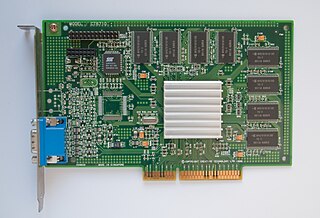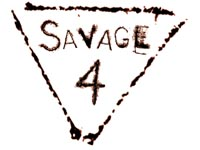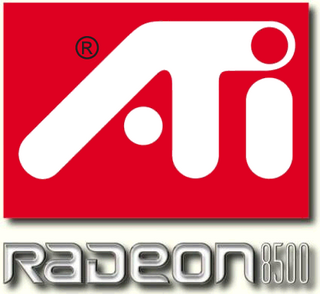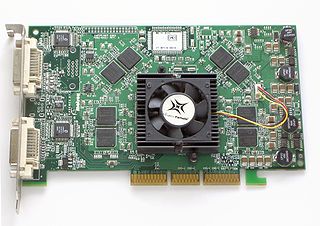
The G200 is a 2D, 3D, and video accelerator chip for personal computers designed by Matrox. It was released in 1998. [1]

The G200 is a 2D, 3D, and video accelerator chip for personal computers designed by Matrox. It was released in 1998. [1]
Matrox had been known for years as a significant player in the high-end 2D graphics accelerator market. Cards they produced were excellent Windows accelerators, and some of the later cards such as Millennium and Mystique excelled at MS-DOS as well. Matrox stepped forward in 1994 with their Impression Plus to innovate with one of the first 3D accelerator boards, but that card could only accelerate a very limited feature set (no texture mapping), and was primarily targeted at CAD applications.
Matrox, seeing the slow but steady growth in interest in 3D graphics on PCs with NVIDIA, Rendition, and ATI's new cards, began experimenting with 3D acceleration more aggressively and produced the Mystique. Mystique was their most feature-rich 3D accelerator in 1997, but still lacked key features including bilinear filtering and alpha blending. Then, in early 1998, Matrox teamed up with PowerVR to produce an add-in 3D board called Matrox m3D using the PowerVR PCX2 chipset. This board was one of the very few times that Matrox would outsource for their graphics processor, and was certainly a stop-gap measure to hold out until the G200 project was ready to go.
With the G200, Matrox aimed to combine its past products' competent 2D and video acceleration with a full-featured 3D accelerator. The G200 chip was used on several boards, most notably the Millennium G200 and Mystique G200. Millennium G200 received the new SGRAM memory and a faster RAMDAC, while Mystique G200 was cheaper and equipped with slower SDRAM memory but gained a TV-out port. Most G200 boards shipped standard with 8 MB RAM and were expandable to 16 MB with an add-on module. The cards also had ports for special add-on boards, such as the Rainbow Runner, which could add various functionality.
G200 was Matrox's first fully AGP-compliant graphics processor. While the earlier Millennium II had been adapted to AGP, it did not support the full AGP feature set. G200 takes advantage of DIME (Direct Memory Execute) to speed texture transfers to and from main system RAM. This allows G200 to use system RAM as texture storage if the card's local RAM is of insufficient size for the task at hand. G200 was one of the first cards to support this feature[ citation needed ].
The chip is a 128-bit core containing dual 64-bit buses in what Matrox calls a "DualBus" organization. Each bus is unidirectional and is designed to speed data transfer to and from the functional units within the chip. By doubling the internal data path with two separate buses instead of just a wider single bus, Matrox reduced latencies in data transfer by improving overall bus efficiency. [2] The memory interface was 64-bit.
G200 supported full 32-bit color depth rendering which substantially pushed the image quality upwards by eliminating dithering artifacts caused by the then-more-typical 16-bit color depth. Matrox called their technology Vibrant Color Quality (VCQ). The chip also supported features such as trilinear mip-map filtering and anti-aliasing (though this was rarely used). The G200 could render 3D at all resolutions supported in 2D. Architecturally, the 3D pipeline was laid out as a single pixel pipeline with a single texture management unit. The core contained a RISC processor called the "WARP core", that implemented a triangle setup engine in microcode.
G200 was Matrox's first graphics processor to require added cooling in the form of a heatsink.
With regards to 2D, G200 was excellent in speed and delivered Matrox's renowned analog signal quality. The G200 bested the older Millennium II in almost every area except extremely high resolutions. With 3D, it scored similar to but generally behind a single Voodoo2 in Direct3D, and was slower than NVIDIA Riva TNT and S3 Savage 3D. However, it was not far behind and was certainly competitive. [3] [4] G200's 3D image quality was considered one of the best due to its support of 32-bit color depth (assuming driver bugs weren't a problem).
G200's biggest problem was its OpenGL support. Throughout most of its life G200 had to get by, in popular games such as Quake II , with a slow OpenGL-to-Direct3D wrapper driver. This was a layer that translated OpenGL to run on the Direct3D driver. This hurt G200's performance dramatically in these games and caused a lot of controversy over continuing delays and promises from Matrox. [5] In fact, it would not be until well into the life of G200's successor, G400, that the OpenGL driver would finally be mature and fast.
Early drivers had some problems with Direct3D as well. In Unreal , for example, there were problems with distortions on the ground textures caused by a bug with the board's subpixel accuracy function. There were also some problems with mip-mapping causing flickering in textures. As drivers matured these problems disappeared.
Matrox G200 series, especially the G200e is still a popular choice for server motherboard manufacturers, like Dell's PowerEdge series, due to its robustness, low power consumption and limited features needed just for VGA display. [6]
Around 1999, Matrox introduced a newer version of G200, called G200A. This board used a newer 250 nm manufacturing process instead of G200's original 350 nm. This allowed Matrox to build more graphics processors per wafer at the factory as well as to reduce heat output of the chip, so G200A had no need in a heat sink while operating at the clock speed of G200. The last revision of G200A was named G250 featuring somewhat higher core and memory clock speeds. It also made use of the same 6ns SGRAM chips as G400, though only two compared to G200 and G200A with four 7ns SGRAM chips. G250 was offered only to OEMs, with Hewlett-Packard perhaps being the only buyer. [7] [8]
| Board Name | Core Type | Process | Core (MHz) | Memory (MHz) | Pipe Config | T&L? | Memory Interface | Notes |
|---|---|---|---|---|---|---|---|---|
| Millennium G200 | Eclipse | 350 nm | 84–90 | 112–120 | 1×1 | No | 64-bit | SGRAM. "SD" model uses SDRAM. "LE" max 8 MB SDRAM. 250 MHz RAMDAC. AGP/PCI |
| Mystique G200 | Eclipse | 350 nm | 84 | 112 | 1×1 | No | 64-bit | SDRAM. 230 MHz RAMDAC. TV out. AGP. |
| Marvel G200 | Eclipse | 350 nm | 84 | 112 | 1×1 | No | 64-bit | SDRAM. 230 MHz RAMDAC. TV in & out. Breakout box for extra I/O. AGP/PCI |
| G200 MMS | Eclipse | 350 nm | 1×1 | No | 64-bit | Quad GPU graphics card for 4 monitor support. Some have TV input. PCI | ||
| Millennium G200A | Calao | 250 nm | 84 | 112 | 1×1 | No | 64-bit | Die-shrink G200. "LE" max 8 MB SDRAM. 250 MHz RAMDAC. No heatsink. Power Consumption 4 Watts. AGP/PCI |
| Millennium G250 | Calao | 250 nm | 96 | 128 | 1×1 | No | 64-bit | overclocked G200A, OEM-only. |

Matrox Graphics, Inc. is a producer of video card components and equipment for personal computers and workstations. Based in Dorval, Quebec, Canada, it was founded in 1976 by Lorne Trottier and Branko Matić. The name is derived from "Ma" in Matić and "Tro" in Trottier.

The GeForce 256 is the original release in Nvidia's "GeForce" product line. Announced on August 31, 1999 and released on October 11, 1999, the GeForce 256 improves on its predecessor by increasing the number of fixed pixel pipelines, offloading host geometry calculations to a hardware transform and lighting (T&L) engine, and adding hardware motion compensation for MPEG-2 video. It offered a notably large leap in 3D PC gaming performance and was the first fully Direct3D 7-compliant 3D accelerator.

3dfx Interactive, Inc. was an American computer hardware company headquartered in San Jose, California, founded in 1994, that specialized in the manufacturing of 3D graphics processing units, and later, video cards. It was a pioneer in the field from the late 1990s to 2000.

A graphics processing unit (GPU) is a specialized electronic circuit initially designed to accelerate computer graphics and image processing. After their initial design, GPUs were found to be useful for non-graphic calculations involving embarrassingly parallel problems due to their parallel structure. Other non-graphical uses include the training of neural networks and cryptocurrency mining.

3Dlabs was a fabless semiconductor company. It was founded by Yavuz Ahıska and Osman Kent in 1994 with headquarters in San Jose, California. It originally developed the GLINT and PERMEDIA high-end graphics chip technology that was used on many of the world's leading computer graphics cards in the CAD and DCC markets, including its own Wildcat and Oxygen cards.

The RIVA 128, or "NV3", was a consumer graphics processing unit created in 1997 by Nvidia. It was the first to integrate 3D acceleration in addition to traditional 2D and video acceleration. Its name is an acronym for Real-time Interactive Video and Animation accelerator.

The RIVA TNT, codenamed NV4, is a 2D, video, and 3D graphics accelerator chip for PCs that was developed by Nvidia and released in March 1998. It cemented Nvidia's reputation as a worthy rival within the developing consumer 3D graphics adapter industry. It succeeded the RIVA 128.

The RIVA TNT2 is a graphics processing unit manufactured by Nvidia starting in early 1999. The chip is codenamed "NV5" because it is the 5th graphics chip design by Nvidia, succeeding the RIVA TNT (NV4). RIVA is an acronym for Real-time Interactive Video and Animation accelerator. The "TNT" suffix refers to the chip's ability to work on two texels at once. Nvidia removed RIVA from the name later in the chip's lifetime.

The S3 ViRGE (Video and Rendering Graphics Engine) graphics chipset was one of the first 2D/3D accelerators designed for the mass market.

The Nvidia NV1, manufactured by SGS-Thomson Microelectronics under the model name STG2000, was a multimedia PCI card announced in May 1995 and released in November 1995. It was sold to retail by Diamond as the Diamond Edge 3D.

Savage was a product-line of PC graphics chipsets designed by S3.

The R200 is the second generation of GPUs used in Radeon graphics cards and developed by ATI Technologies. This GPU features 3D acceleration based upon Microsoft Direct3D 8.1 and OpenGL 1.3, a major improvement in features and performance compared to the preceding Radeon R100 design. The GPU also includes 2D GUI acceleration, video acceleration, and multiple display outputs. "R200" refers to the development codename of the initially released GPU of the generation. It is the basis for a variety of other succeeding products.

Diamond Multimedia is an American company that specializes in many forms of multimedia technology. They have produced graphics cards, motherboards, modems, sound cards and MP3 players; however, the company began with the production of the TrackStar, a PC add-on card which emulated Apple II computers. They were one of the major players in the 2D and early 3D graphics card competition throughout the 1990s and early 2000s.

Rendition, Inc., was a maker of 3D computer graphics chipsets in the mid to late 1990s. They were known for products such as the Vérité 1000 and Vérité 2x00 and for being one of the first 3D chipset makers to directly work with Quake developer John Carmack to make a hardware-accelerated version of the game (vQuake). Rendition's major competitor at the time was 3Dfx. Their proprietary rendering APIs were Speedy3D and RRedline.

The ATI Rage is a series of graphics chipsets developed by ATI Technologies offering graphical user interface (GUI) 2D acceleration, video acceleration, and 3D acceleration developed by ATI Technologies. It is the successor to the ATI Mach series of 2D accelerators.

The Matrox Parhelia-512 is a graphics processing unit (GPU) released by Matrox in 2002. It has full support for DirectX 8.1 and incorporates several DirectX 9.0 features. At the time of its release, it was best known for its ability to drive three monitors and its Coral Reef tech demo.
The G400 is a video card made by Matrox, released in September 1999. The graphics processor contains a 2D GUI, video, and Direct3D 6.0 3D accelerator. Codenamed "Toucan", it was a more powerful and refined version of its predecessor, the G200.

The Mystique and Mystique 220 were 2D, 3D, and video accelerator cards for personal computers designed by Matrox, using the VGA connector. The original Mystique was introduced in 1996, with the slightly upgraded Mystique 220 having been released in 1997.

The Voodoo2 is a set of three specialized 3D graphics chips on a single chipset setup, made by 3dfx. It was released in February 1998 as a replacement for the original Voodoo Graphics chipset. The card runs at a chipset clock rate of 90 MHz and uses 100 MHz EDO DRAM, and is available for the PCI interface. The Voodoo2 comes in two models, one with 8 MB RAM and one with 12 MB RAM. The 8 MB card has 2 MB of memory per texture mapping unit (TMU) vs. 4 MB on the 12 MB model. The 4 MB framebuffer on both cards support a maximum screen resolution of 800 × 600, while the increased texture memory on the 12 MB card allows more detailed textures. Some boards with 8 MB can be upgraded to 12 MB with an additional daughter board.

The R300 GPU, introduced in August 2002 and developed by ATI Technologies, is its third generation of GPU used in Radeon graphics cards. This GPU features 3D acceleration based upon Direct3D 9.0 and OpenGL 2.0, a major improvement in features and performance compared to the preceding R200 design. R300 was the first fully Direct3D 9-capable consumer graphics chip. The processors also include 2D GUI acceleration, video acceleration, and multiple display outputs.